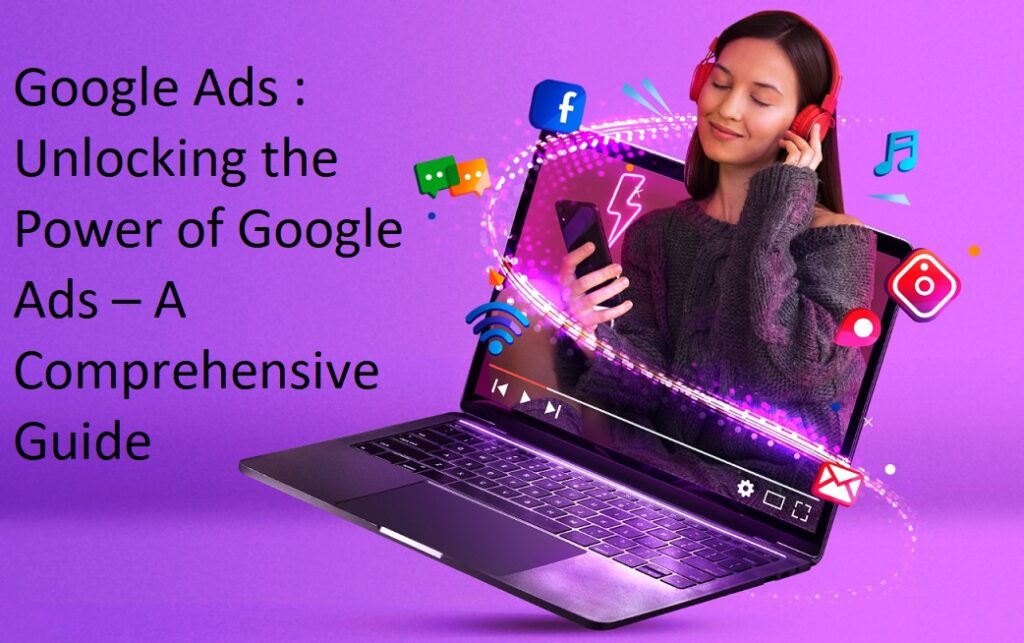Google Ads : Unlocking the Power of Google Ads – Check Details

In today’s digital age, Google Ads has taken a new turn with online platforms for advertisement. This powerful tool allows businesses to reach their target audience in a highly effective and targeted manner. Whether you’re a small startup or an established enterprise, Google Ads has the potential to boost your online visibility, drive traffic, and increase conversions. In this comprehensive guide, we’ll delve into the world of Google Ads, Digital Marketing and explore how you can harness its potential to propel your business forward.
Understanding Google Ads
What are Google Ads?
Google Ads means a platform for advertisement which is created by Google. It enables businesses to create and display ads on Google’s search engine results pages (SERPs), as well as on other Google properties and partner websites.
How it work?
Google Ads operates on a pay-per-click (PPC) model, meaning advertisers only pay when a user clicks on their ad. Advertisers bid on relevant keywords, and Google uses a complex algorithm to determine which ads appear on the SERPs and in what order. Ad placement is influenced by factors like bid amount, ad quality, and ad extensions.
Types of Google Ads
Search Ads
It is the widely used term for Google Ads. They appear at the top and bottom of search results pages when users enter relevant keywords. These ads are text-based and consist of a headline, display URL, and description. They are highly effective for capturing users actively searching for specific products or services.
Display Ads
Display ads are visual advertisements that appear on websites within Google’s extensive network. They include images, banners, and even interactive elements. Display ads are ideal for brand awareness and retargeting, as they can be tailored to specific demographics and interests.
Video Ads
YouTube and the Google Display Network both feature video advertisements. They can be skippable or non-skippable and allow advertisers to engage users through visual storytelling. Video ads are a powerful way to showcase products, services, or brand messages.
App Promotion Ads
App promotion ads aim to increase app installations and engagement. These ads can appear on various platforms, including the Google Search Network, Google Play Store, YouTube, and third-party apps. They often include a direct link to the app’s download page.
Creating a Successful Google Ads Campaign

Setting Clear Objectives
Define your marketing objectives before launching Google Ads. Are you trying to increase sales, internet traffic, leads, or brand awareness? Your campaign strategy will be guided by clear goals.
Conducting Keyword Research
Keyword research is the foundation of a successful campaign. Choose appropriate search terms that clients might use to find your goods or services. Utilize tools like Google’s Keyword Planner to uncover high-traffic and low-competition keywords.

Crafting Compelling Ad Copy
Write ad copy that speaks directly to your target audience’s pain points and needs. Use persuasive language, highlight unique selling points, and include a strong call to action (CTA) that prompts users to take action.
Designing High-Impact Visuals
Visuals play a significant role in ad engagement. Ensure your images and videos are of high quality and align with your brand identity. A compelling visual can capture users’ attention and encourage them to click.
Bid Strategies and Budget Allocation
Set a realistic budget for your campaign and choose the appropriate bidding strategy. Google offers options like cost-per-click (CPC), cost-per-thousand-impressions (CPM), and cost-per-acquisition (CPA).
Targeting the Right Audience
Demographic Targeting
Tailor your ads to specific demographics such as age, gender, marital status, and income level.
Geographical Targeting
Geo-targeting allows you to display ads to users in specific locations. This is essential for businesses with localized offerings.
Behavioral Targeting
Behavioral targeting considers users’ online behaviors and interests. Reach users who have shown an affinity for products or services similar to yours.
Remarketing Strategies
Remarketing is focusing on customers who have already interacted with your website or advertisements. This aids in re-engaging potential clients and promoting conversions.

Maximizing Ad Performance
A/B Testing for Ad Variations
Run A/B tests to compare different ad variations and determine which elements resonate best with your audience. Test headlines, images, CTAs, and ad formats.
Quality Score Importance
Google assigns a Quality Score to each keyword in your campaign. Focus on relevant keywords, landing page quality, and click-through rates.
Ad Extensions for Enhanced Engagement
Ad extensions provide additional information or features within your ads, such as phone numbers, site links, and location details. Use them to provide more value and encourage interaction.
Monitoring and Optimization
Tracking Conversions and Metrics
Keep an eye on important statistics like click-through rates (CTR), conversion rates, and return on ad spend (ROAS) on a regular basis. To learn more about user activity, use tools like Google Analytics.
Adjusting Strategies for Better ROI
Based on your performance data, refine your campaign strategies. Allocate budget to high-performing keywords, pause underperforming ads, and adjust bids as needed.
Ad Schedule Optimization
Consider when your target audience is most active and adjust your ad schedule accordingly. This ensures your ads are shown at optimal times.
Common Mistakes to Avoid
Overlooking Negative Keywords
These keywords stop your ads for displaying for irrelevant search. Regularly update your list of negative keywords to save on ad spend.
Ignoring Mobile Users
Optimize your ads for mobile devices, as a significant portion of users browse on smartphones. Ensure landing pages are mobile-responsive for a seamless experience.
Neglecting Landing
Page Quality
A high-quality landing page is crucial for conversions. Ensure your landing page aligns with your ad’s message and provides a clear path for users to take action.
The Future of Google Ads
Machine Learning and Automation
Google Ads continues to integrate machine learning for better targeting and ad optimization. Automation features can enhance campaign performance and save time.
Voice Search Integration
As voice search grows, optimizing your ads for voice queries becomes essential. Focus on conversational keywords and concise, informative ad copy.
Visual Search Opportunities
It allows users to search using images instead of text. Visual ads and optimized images will become increasingly important.

Finiallizing The Google Ads
In the rapidly evolving digital landscape, Google Ads stands as a powerful tool for businesses to connect with their audience. By understanding its various types, strategies, and optimization techniques, you can unlock the full potential of this platform. Start your journey with Google Ads today and watch your business soar to new heights. Lets design your own WordPress website and start sharing your experience and fully utilize the Google Ads feature.
FAQs (Google Ads)
How do I create a Google Ads account?
A: Visit the Google Ads website and follow the prompts to set up your account. You’ll need to provide your business information and payment details.
Can I run ads for a local business only?
A: Absolutely! Google Ads allows for precise geographical targeting, making it ideal for local businesses to reach their community.
What is Quality Score, and why is it important?
A: Quality Score is a metric that determines the quality and relevance of your ads and keywords.
Are there any budget limitations for Google Ads campaigns?
A: Google Ads allows you to set your budget based on your goals. You can adjust your budget at any time to suit your needs.
How do I track the effectiveness of my Google Ads campaigns?
A: Utilize tools like Google Analytics to track metrics such as clicks, conversions, and bounce rates. This data will help you optimize your campaigns for better results.



